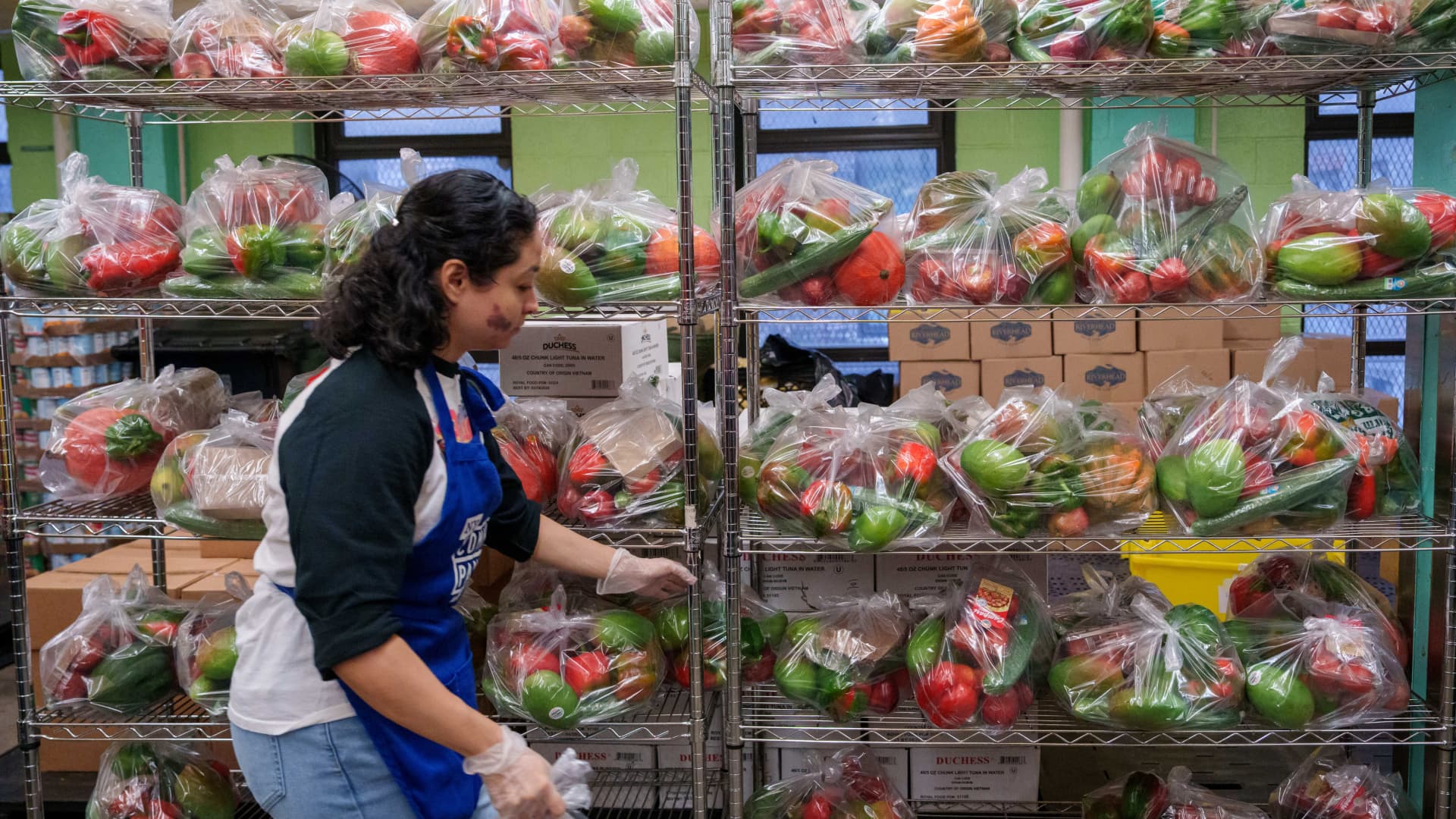Millions of Americans are living in fear that they will go hungry due to potential delays in SNAP food assistance benefit payments, even after a federal judge ordered the Trump administration to make payments in November. That’s in a nation where close to $400 billion in food is estimated to be at risk of going to waste every year.
ReFED, a U.S.-based nonprofit that focuses on food waste, recently released its 2025 report showing that $382 billion in surplus food was produced in 2023, the most recent year statistics were available.
“Forty percent of all food is headed for the bin globally,” said Chris MacAulay, head of surplus food marketplace Too Good to Go’s North American operation, which has expanded to 70 cities. “Visualize what that means — it would be like standing in front of the refrigerator and dumping half of it out. It is an incredible amount of waste,” MacAulay said.
Too Good to Go doesn’t divert excess food that might find its way into food banks, but provides an outlet for food that might typically get tossed. It matches grocery stores and restaurants that have surplus food with customers seeking to reasonably priced food. For instance, a local pizza parlor might have some extra pies at the end of the night. Instead of tossing them into the dumpster, they can at least recoup something by offering them on Too Good to Go. Consumers are matched with a “surprise bag” that contains food that would otherwise be sent to the landfill. Too Good to Go estimates eight meals get saved every second through its marketplace.
“We know many Americans are feeling greater strain on their grocery budgets, especially in light of the upcoming possible lapse in SNAP benefits,” MacAulay said. “You don’t know what you are going to get, but you will get great food at a 50 to 60 percent discount,” he added.
The current SNAP crisis come amid broader cuts to the food assistance program included in the Trump administration’s tax cuts, which will reduce the payments across the U.S.
Donation, composting, animal feed, and surplus food marketplaces are primary options for food waste.
“There is not one solution, it’s a combination of solutions. We think of it as a food waste supply chain,” MacAulay said, adding that grocers in particular find its marketplace a good fit for their surplus.
His organization isn’t alone in seeing the need for more solutions to the problem. Increasingly, everyone from large investors to mom-and-pop shops are finding that there are dollars to be salvaged in the food waste business, and people to be fed.
“The amount of transaction activity and the amount of interest in the sector is pretty impressive,” said Effram Kaplan, senior managing director at Brown Gibbons Lang & Company, who heads its investment banking in environmental services, environmental infrastructure, and energy transition.
Kaplan says that while waste management businesses are nothing new, the consistency and predictability of returns is catching increased investor attention. “I’ve been in this business for 25 years, and I believe that it’s been undervalued for some time,” he said.
Sophisticated, deep-pocketed infrastructure investors who are looking for stable returns are discovering that waste delivers profits in the U.S. “While that type of capital has been prevalent in Europe for some time, it’s only just begun here,” Kaplan said.
Barriers to entry in the business are going down, but getting into the business still requires significant investment, often in equipment.
“I think it is easier than ever as technology lowers the barrier to entry if you come up with a good idea,” MacAulay said.
Food waste from home to commercial kitchen
Some solutions are going right to the consumer. Mill, a startup founded by one of the creators of the Nest smart thermostat, has $100 million in funding for its smart kitchen bin that dries, shrinks, and de-stinks leftover food, eliminating food waste.
Other approaches are entering at the commercial point of waste. Metafoodx, a startup that raised $9.4 million in Series A funding in May 2024, has built a 3D AI scanner that tracks food in commercial kitchens — what’s being used, what’s wasted, and where improvements can be made.
Buddy Bockweg, CEO of Vsimple, which works with industrial and environmental service companies (including waste management providers) to digitize and streamline operations, from field dispatch to invoicing, say start-ups have a unique ability to deploy technology to compete with larger players.
“AI is able to streamline everything on the dispatch side,” Bockweg said. “The ones that are investing in technology to advance their operations are the ones that are winning and making more money.”
Tyler Frank, president and founder of Portland, Maine-based Garbage to Garden, started small and has scaled up. He launched his business in 2012 with $300 and one truck after realizing, while living in his apartment, that there was no easy way to compost his waste. Garbage to Garden supplies compost buckets and a subscription-based route pickup. The waste is composted and supplied to area farms, or subscribers can have soil delivered back to them.
“I think that the way that I did it was low barrier to entry, but it was a very long, difficult hill to climb. You have to achieve economies of scale,” Frank said. He was motivated in part by the knowledge that waste will be a business regardless of other economic factors. “This is a recession-resilient business and an idea whose time has come,” Frank said.
What started out as a one-bucket-at-a-time subscription is growing into more and more municipal contracts. Garbage to Garden now serves 50,000 subscribers and has landed pickup contracts in cities like Boston and Medford, Massachusetts.
Lower-income households waste less
While Frank’s business model doesn’t tackle the problem of hunger — in fact, there may be less composted waste as people seek to squeeze everything they can out of their food during SNAP delays — he says the overall trend and flow of food waste is up.
Ben Scharadin, professor of economics at Colby College, says the government does play a large role in the innovation and growth taking place in the sector due to federal waste reduction mandates and a desire for businesses to be more efficient.
But a cruel irony of the current situation is that SNAP beneficiaries are more likely to waste less food than others.
“Lower-income households usually have lower food waste rates than higher-income households. If you have a stricter budget constraint, there is not much wiggle room in households,” Scharadin said. “Lower-income and SNAP households are better at planning their food intake because they have to be,” he said.
Scharadin says younger and more affluent households tend to waste the most and that subscription compost services would be considered a premium. The circular economy should be bracing for some impact from the SNAP cuts, he said, and business models such as Too Good to Go should benefit.
“As things get tighter on the budget end for consumers, there will be a quicker turn to surprise bags and secondary markets that are seemingly slightly lower quality,” Scharadin said.
Still, despite more companies finding novel ways to attack the waste issue, “the first goal in food waste should be to reduce it,” Scharadin said.





